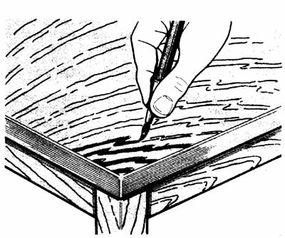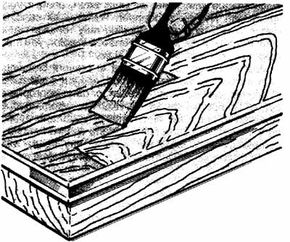Staining Techniques for Wood Furniture
Whatever type of stain you're using, the most important part of the process is getting the color you want. You may be able to buy stain in the color you want. If not, and if you have a sample of the stain color you want, take it to the paint store and have a color mixed to match. Experiment, mixing small amounts of stain and applying test batches to scrap wood, until you get the right color.
Although a wide range of stain colors is available, you can mix almost any color with two or more of the four basic shades: light oak (tan), walnut (brown), maple (yellow-orange), and mahogany (red). Most manufacturers provide mixing proportions for various effects.
Advertisement
To dull any color, add a drop or two of black. Mix small amounts of stain at first; then, starting full-strength and thinning the stain gradually with the proper solvent, test the stain on scrap wood until you have the right color. Keep track of the proportions so you'll be able to duplicate the mixture. When you like the color, test it again on a hidden part of the piece of furniture. If the piece is made of two or more woods, you may have to mix stain separately for each wood, but this is often not necessary.
When you're satisfied with the stain color, mix enough stain to treat the entire piece of furniture. Do not mix brands or types of stain, and do not change brands or types in the middle of the job. It's better to have stain left over than to run out of stain with one table leg or chair arm to go.
Whatever stain you're using, it's best to go carefully. If you're not sure the color is right, thin the stain to lighten it and apply several coats of stain until the color is as deep as you want it. Always test the stain in an inconspicuous spot, and stain the least conspicuous surfaces first. It may take longer this way to get the effect you want, but the only way to salvage a badly applied stain is to bleach it out and start over.
To prevent drip marks and uneven color, turn the piece of furniture so that the surface being stained is always horizontal. If you're working on a large piece and this isn't practical, start at the bottom and work up. Always work quickly, applying stain smoothly and evenly over the entire surface.
Pigmented or Penetrating Oil Stains
Apply pigmented or penetrating oil stain with a clean brush, flowing stain evenly along the grain of the wood. You can also use a clean cloth or sponge to apply penetrating stain. Let pigmented oil stain set for about 10 to 15 minutes, until the surface of the stain starts to turn dull, then firmly wipe off the excess stain with a clean cloth dampened with stain.
Penetrating oil stains work more quickly than pigmented ones. Wipe off the excess immediately for a light color, or let it set as long as 15 to 20 minutes for a darker color.
Oil stain can be modified to some extent if you don't like the effect. If the wood is too dark, soak a clean cloth in turpentine or mineral spirits and rub the wood firmly and evenly along the grain. This will lighten the stain but not remove it. If part of the grain is too dark, wrap a cloth around your index finger, dip it into turpentine or mineral spirits, and lightly rub the grain you want lightened. If part of the grain is too light, use an artists' brush to carefully apply more stain just to the grain.
Let the completed stain dry for about 24 hours. If the color isn't dark enough, repeat the staining procedure.
Water-base Stains
Water-base stains should be used on clean, bare wood or on new wood. Apply stain with a new brush, flowing it on quickly and evenly along the grain of the wood. Use long, smooth strokes. Try not to overlap your strokes; a double layer of stain will dry twice as dark as a single one. It's better to use several thinned coats of stain than one dark one to minimize brush overlap marks.
Water-base stain can be adjusted if you're working on relatively small surfaces. To apply water-base stain by this method, flow it onto the surface liberally; then wipe off the excess, stroking along the grain with a clean cloth. The intensity of the color is determined by the length of time the excess is left on the wood; wipe immediately for a light color or let the stain set for a darker shade. Let the completed stain dry for about 24 hours. If the color isn't dark enough, repeat the staining procedure.

NGR Stains
NGR stain, either alcohol- or spirit-base, is applied like water-base stain, but this type of stain dries so quickly that it can be hard to apply. Use a medium-size new brush to apply NGR stain, flowing it on quickly and evenly along the grain of the wood. Make long, smooth, light strokes, and try not to overlap the strokes. Brush overlap marks will dry twice as dark as the rest of the stain.
To minimize overlap marks, it's better to use several thinned coats of stain than one dark one.
NGR stains cannot be adjusted and should not be applied in very humid weather. An unsatisfactory stain must be bleached out. Let the stain dry completely before finishing the wood -- about half an hour for alcohol-base stain and about one hour for methanol- or other spirit-base stain.
Lightening
Dark wood can be lightened with stain for an interesting light-dark effect. Lightening is not recommended for fine woods because it covers the natural color and grain of the wood; as a last resort, though, it can be effective. Lightening works best on open-grained wood; the effect of a lighter color is produced because the grain is filled with a light or white pigment. The lightening agent is sometimes thinned white oil-base paint, but more often it is pigmented oil stain.
Apply the oil stain as above, and let it set to achieve the desired effect. Wipe off excess stain, and let the stained wood dry completely.
Post-Stain Treatment
Any stain, even an oil-base stain, may raise the grain of the wood slightly. If necessary, remove this slight roughness when the stain is completely dry, but smooth the wood very carefully to avoid removing the stain. To smooth wood treated with oil-base stain, rub it gently with No. 000 or 0000 steel wool. To smooth wood treated with water-base or NGR stain, sand it very lightly with fine-grit sandpaper. Remove all sanding debris with a tack cloth. Sanding may remove water-base stain in spots; if the surface is uneven in color, you may have to apply another coat of stain.
To complete your post-stain treatment, you will have to apply a coat of sealer. For a full explanation of this process, move on to the next section.
